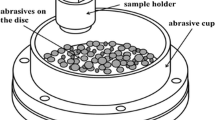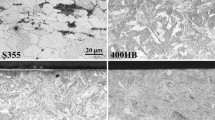Abstract
Duplex high-carbon steel is widely used in ball mills in the form of grinding balls and thus subjected to impact loads during the normal operation of the mill. The influence of impact loading at different impact energies is investigated in this paper. Impact tests using a drop tower were performed in the regime of 100–150 J, and the mechanical response of the material was recorded. The deformation behaviour of the material was classified into two groups: (a) low-impact-energy regime (100–120 J) where the material bulged without fracture and (b) high-impact-energy regime (130–150 J) where the material faced catastrophic failure. An overall increase in the load-bearing capacity of the material was found with an increase in the impact energy. The energy–time curves exhibited both linear and nonlinear regions which were attributed to the nucleation and propagation of cracks. Shear bands were observed in the specimens which underwent catastrophic fracture (i.e. 130 J and above); however, significant changes in the features of shear bands were noticed with increase in the impact energy. Fracture surfaces displayed the presence of microvoids, dimples, knobby fracture and river pattern, thus indicating ductile as well as a brittle mode of failure. Transmission electron microscopy results revealed the presence of much finer nano-grains inside the shear bands as compared to the surrounding regions. Finite element simulations exhibited an increase in the shear stress with the propagation of shear bands during the ongoing deformation process.















Similar content being viewed by others
Data availability
The raw/processed data required to reproduce these findings will be made available on request.
References
Liu ZG, Fecht HJ, Xu Y, Yin J, Tsuchiya K, Umemoto M. Electron-microscopy investigation on nanocrystal formation in pure Fe and carbon steel during ball milling. Mater Sci Eng A. 2003;362:322–6. https://doi.org/10.1016/S0921-5093(03)00631-2.
Manjanna J, Kobayashi S, Kamada Y, Takahashi S, Kikuchi H. Martensitic transformation in SUS 316LN austenitic stainless steel at RT. J Mater Sci. 2008;43:2659–65. https://doi.org/10.1007/s10853-008-2494-4.
Massola CP, Chaves AP, Albertin E. A discussion on the measurement of grinding media wear. J Mater Res Technol. 2016;5:282–8. https://doi.org/10.1016/j.jmrt.2015.12.003.
Gawlik J, Schmidt J, Nowak T, Wójcicki Z, Zagórski A. Nitrogen as an alloying element improving material properties of the high carbon cast steel for ball mill liner plates. Arch Civ Mech Eng. 2017;17:926–34. https://doi.org/10.1016/j.acme.2017.04.007.
Banerjee A, Prusty BG. Fatigue and fracture behaviour of austenitic-martensitic high carbon steel under high cycle fatigue: an experimental investigation. Mater Sci Eng A. 2019;749:79–88. https://doi.org/10.1016/j.msea.2019.02.010.
Chenje TW, Simbi DJ, Navara E. Relationship between microstructure, hardness, impact toughness and wear performance of selected grinding media for mineral ore milling operations. Mater Des. 2004;25:11–8. https://doi.org/10.1016/S0261-3069(03)00168-7.
Gangopadhyay AK, Moore JJ. Effect of impact on the grinding media and mill liner in a large semiautogenous mill. Wear. 1987;114:249–60. https://doi.org/10.1016/0043-1648(87)90091-3.
Szymczak T, Makowska K, Kowalewski ZL, Lasota PJIJOM. An influence of impact energy on magnesium alloy behaviour. Int J Mech Mater Des. 2019. https://doi.org/10.1007/s10999-019-09461-1.
Dai H-L, Yan X, Jiang H-JJIJOM. Investigation on thermomechanical behavior of a HSLA steel circular plate under impact load. Int J Mech Mater Des. 2014;10:411–20. https://doi.org/10.1007/s10999-014-9251-4.
Prato A, Longana ML. A novel approach for the investigation of low energy ice impacts. Int J Impact Eng. 2018;121:12–9. https://doi.org/10.1016/j.ijimpeng.2018.06.003.
Hossain R, Pahlevani F, Witteveen E, Banerjee A, Joe B, Prusty BG, Dippenaar R, Sahajwalla V. Hybrid structure of white layer in high carbon steel—formation mechanism and its properties. Sci Rep. 2017;7:13288. https://doi.org/10.1038/s41598-017-13749-7.
Longère P. Adiabatic shear banding assisted dynamic failure: Some modeling issues. Mech Mater. 2018;116:49–66. https://doi.org/10.1016/j.mechmat.2017.03.021.
Darabi AC, Chamani HR, Kadkhodapour J, Anaraki AP, Alaie A, Ayatollahi MR. Micromechanical analysis of two heat-treated dual phase steels: DP800 and DP980. Mech Mater. 2017;110:68–83. https://doi.org/10.1016/j.mechmat.2017.04.009.
Yuan F, Bian X, Jiang P, Yang M, Wu X. Dynamic shear response and evolution mechanisms of adiabatic shear band in an ultrafine-grained austenite–ferrite duplex steel. Mech Mater. 2015;89:47–58. https://doi.org/10.1016/j.mechmat.2015.06.004.
Benzerga AA, Thomas N, Herrington JS. Plastic flow anisotropy drives shear fracture. Sci Rep. 2019;9:1425. https://doi.org/10.1038/s41598-018-38437-y.
Lei Z, Hong Y, Xie J, Sun C, Zhao A. Effects of inclusion size and location on very-high-cycle fatigue behavior for high strength steels. Mater Sci Eng A. 2012;558:234–41. https://doi.org/10.1016/j.msea.2012.07.118.
Park KS, Cho SJ, Lee KY, Kim GS, Lee CS. Effect of volume fraction of undissolved cementite on the high cycle fatigue properties of high carbon steels. Int J Fatigue. 2007;29:1863–7. https://doi.org/10.1016/j.ijfatigue.2007.01.001.
Chandrasekaran T, Natarajan KA, Kishore. Influence of microstructure on the wear of grinding media. Wear. 1991;147:267–74. https://doi.org/10.1016/0043-1648(91)90184-V.
Modi OP, Mondal DP, Prasad BK, Singh M, Khaira HK. Abrasive wear behaviour of a high carbon steel: effects of microstructure and experimental parameters and correlation with mechanical properties. Mater Sci Eng A. 2003;343:235–42. https://doi.org/10.1016/S0921-5093(02)00384-2.
Banerjee A, Prusty BG, Bhattacharyya S. Rate-dependent mechanical strength and flow behaviour of dual-phase high carbon steel at elevated temperatures: an experimental investigation. Mater Sci Eng A. 2019;744:224–34. https://doi.org/10.1016/j.msea.2018.12.002.
Banerjee A, Hossain R, Pahlevani F, Zhu Q, Sahajwalla V, Prusty BG. Strain-rate-dependent deformation behaviour of high-carbon steel in compression: mechanical and structural characterisation. J Mater Sci. 2019;54:6594–607. https://doi.org/10.1007/s10853-018-03301-x.
Banerjee A, Prusty BG, Zhu Q, Pahlevani F, Sahajwalla V. Strain-rate-dependent deformation behavior of high-carbon steel under tensile-compressive loading. JOM. 2019;71:2757–69. https://doi.org/10.1007/s11837-019-03594-6.
Lee W-S, Liu C-Y. The effects of temperature and strain rate on the dynamic flow behaviour of different steels. Mater Sci Eng A. 2006;426:101–13. https://doi.org/10.1016/j.msea.2006.03.087.
Banerjee A, Wang H, Brown A, Ameri A, Zhu Q, Bhattacharyya S, Hazell PJ, Prusty BG. Experimental investigation on the dynamic flow behaviour and structure–property correlation of dual-phase high carbon steel at elevated temperatures. Mater Sci Eng A. 2020;771:138655. https://doi.org/10.1016/j.msea.2019.138655.
Wang TS, Yang J, Shang CJ, Li XY, Zhang B, Zhang FC. Microstructures and impact toughness of low-alloy high-carbon steel austempered at low temperature. Scr Mater. 2009;61:434–7. https://doi.org/10.1016/j.scriptamat.2009.04.038.
Standard test method for conducting drop-weight test to determine nil-ductility transition temperature of ferritic steels. In: ASTM E208-17e1. ASTM International, West Conshohocken, 2017; www.astm.org.
International, A. ASTM E3-11. Standard guide for preparation of metallographic specimens. West Conshohocken: ASTM; 2017.
Song J-H, Areias PMA, Belytschko T. A method for dynamic crack and shear band propagation with phantom nodes. Int J Numer Methods Eng. 2006;67:868–93. https://doi.org/10.1002/nme.1652.
Tabarraei A, Song J-H, Waisman H. A two-scale strong discontinuity approach for evolution of shear bands under dynamic impact loads. Int J Multiscale Comput Eng. 2013;11:543–63. https://doi.org/10.1615/IntJMultCompEng.2013005506.
Kamaya M. Ramberg–Osgood type stress–strain curve estimation using yield and ultimate strengths for failure assessments. Int J Press Vessels Pip. 2016;137:1–12. https://doi.org/10.1016/j.ijpvp.2015.04.001.
Salarikia A, Ashtiani S-HM, Golzarian MR, Mohammadinezhad H. Finite element analysis of the dynamic behavior of pear under impact loading. Inf Process Agric. 2017;4:64–77. https://doi.org/10.1016/j.inpa.2016.12.003.
Grajcar A, Kozłowska A, Radwański K, Skowronek A. Quantitative analysis of microstructure evolution in hot-rolled multiphase steel subjected to interrupted tensile test. Metals. 2019;9:1304.
Kozłowska A, Janik A, Radwański K, Grajcar A. Microstructure evolution and mechanical stability of retained austenite in medium-Mn steel deformed at different temperatures. Materials. 2019;12:3042.
Guo L, Kitamura T, Yan Y, Sumigawa T, Huang K. Fracture mechanics investigation on crack propagation in the nano-multilayered materials. Int J Solids Struct. 2015;64–65:208–20. https://doi.org/10.1016/j.ijsolstr.2015.03.025.
Valtonen K, Ratia V, Ramakrishnan KR, Apostol M, Terva J, Kuokkala V-T. Impact wear and mechanical behavior of steels at subzero temperatures. Tribol Int. 2019;129:476–93. https://doi.org/10.1016/j.triboint.2018.08.016.
Kumar S, Curtin WA. Crack interaction with microstructure. Mater Today. 2007;10:34–44. https://doi.org/10.1016/S1369-7021(07)70207-9.
Hayes MD, Edwards DB, Shah AR. 4 Fractography basics. In: Hayes MD, Edwards DB, Shah AR, editors. Fractography in failure analysis of polymers. Oxford: William Andrew Publishing; 2015. p. 48–92. https://doi.org/10.1016/B978-0-323-24272-1.00004-0.
Zou DL, Zhen L, Xu CY, Shao WZ. Characterization of adiabatic shear bands in AM60B magnesium alloy under ballistic impact. Mater Charact. 2011;62:496–502. https://doi.org/10.1016/j.matchar.2011.03.003.
Li GA, Zhen L, Lin C, Gao RS, Tan X, Xu CY. Deformation localization and recrystallization in TC4 alloy under impact condition. Mater Sci Eng A. 2005;395:98–101. https://doi.org/10.1016/j.msea.2004.12.020.
Rodríguez-Martínez JA, Rittel D, Zaera R, Osovski S. Finite element analysis of AISI 304 steel sheets subjected to dynamic tension: the effects of martensitic transformation and plastic strain development on flow localization. Int J Impact Eng. 2013;54:206–16. https://doi.org/10.1016/j.ijimpeng.2012.11.003.
Tzini M-IT, Karamichailidou DA, Haidemenopoulos GN. Grain size evolution during multipass hot-rolling of C–Mn steels: comparison of phase field and extended JMAK modeling. Steel Res Int. 2018;89:1800223. https://doi.org/10.1002/srin.201800223.
Banerjee A, Prusty BG, Bhattacharyya S, Zhu Q. An investigation on the deformation mechanisms of high carbon steel under the influence of thermal and rate-dependent loading. Mater Sci Eng A. 2020;772:138766. https://doi.org/10.1016/j.msea.2019.138766.
Li S-X, Zhao P-C, He Y-N, Yu S-R. Microstructural evolution associated with shear location of AISI 52100 under high strain rate loading. Mater Sci Eng A. 2016;662:46–53. https://doi.org/10.1016/j.msea.2016.03.050.
Xue Q, Gray GT. Development of adiabatic shear bands in annealed 316L stainless steel: part II. TEM studies of the evolution of microstructure during deformation localization. Metall Mater Trans A. 2006;37:2447–58. https://doi.org/10.1007/bf02586218.
Polyzois I, Bassim N. An examination of the formation of adiabatic shear bands in AISI 4340 steel through analysis of grains and grain deformation. Mater Sci Eng A. 2015;631:18–26. https://doi.org/10.1016/j.msea.2015.02.008.
Duan CZ, Zhang LC. Adiabatic shear banding in AISI 1045 steel during high speed machining: Mechanisms of microstructural evolution. Mater Sci Eng A. 2012;532:111–9. https://doi.org/10.1016/j.msea.2011.10.071.
Acknowledgements
This work was financially supported from the Australian Research Council’s Industrial Transformation Research Hub (ARC-ITRH) under the funding scheme (IH130200025). The authors acknowledge ARC Training Centre for Automated Manufacture of Advanced Composites (AMAC) and Mark Wainwright Analytical Centre (MWAC), UNSW Sydney for providing the mechanical and material characterisation facilities. The authors also acknowledge Dr. Matthew David (Centre Manager-AMAC) for his valuable suggestions while conducting the impact tests.
Funding
Funding for this study was obtained from the Australian Research Council’s Industrial Transformation Research Hub (ARC-ITRH) under the funding scheme (IH130200025).
Author information
Authors and Affiliations
Contributions
AB performed the sample preparation, experiments, material characterisation, FEM simulations and data analysis. BGP designed the test matrix and supervised the study. QZ prepared the FIB specimen for TEM study and helped in the TEM investigation. AB wrote the manuscript, and all the authors discussed, edited and approved the manuscript.
Corresponding author
Ethics declarations
Conflict of interest
The authors declare that they have no conflict of interest.
Additional information
Publisher’s Note
Springer Nature remains neutral with regard to jurisdictional claims in published maps and institutional affiliations.
Rights and permissions
About this article
Cite this article
Banerjee, A., Prusty, B.G. & Zhu, Q. Experimental and numerical investigation on the impact resistance of high-carbon low-alloy steel. Archiv.Civ.Mech.Eng 20, 64 (2020). https://doi.org/10.1007/s43452-020-00066-6
Received:
Revised:
Accepted:
Published:
DOI: https://doi.org/10.1007/s43452-020-00066-6




